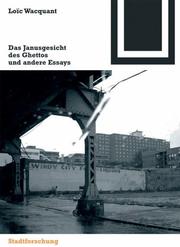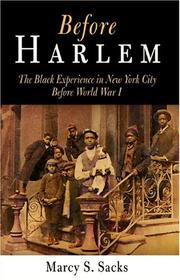| Listing 1 - 5 of 5 |
Sort by
|
Book
ISBN: 2749205883 Year: 2006 Publisher: Bruxelles : Bruylant,
Abstract | Keywords | Export | Availability | Bookmark
 Loading...
Loading...Choose an application
- Reference Manager
- EndNote
- RefWorks (Direct export to RefWorks)
Day care centers --- Inner cities --- Garderies --- Quartiers pauvres --- Pedagogiek en onderwijskunde --- gezinspedagogiek --- gezinspedagogiek.
Book
ISBN: 9221185370 Year: 2006 Publisher: Geneva, Switzerland : International Labour Organization,
Abstract | Keywords | Export | Availability | Bookmark
 Loading...
Loading...Choose an application
- Reference Manager
- EndNote
- RefWorks (Direct export to RefWorks)

ISBN: 3764379634 3764374616 Year: 2006 Publisher: Basel : Birkhauser,
Abstract | Keywords | Export | Availability | Bookmark
 Loading...
Loading...Choose an application
- Reference Manager
- EndNote
- RefWorks (Direct export to RefWorks)
Die hier versammelten Essays gelten dem Zusammenhang von sozialer und ethnischer Ausgrenzung und staatlicher Politik in den Metropolen zu Beginn des 21. Jahrhunderts. Die aus einer erfahrungsgestützten Perspektive geschriebenen Beiträge diagnostizieren die sich überall abzeichnenden Formen städtischer Armut und Gewalt in den entwickelten Gesellschaften des reichen Westens. Der Autor arbeitet mit einem soziologischen Konzept des Ghettos als Instrument ethnischer Kontrolle und Einschließung. Er zeigt, wie sich Staaten zunehmend von der Idee und der Praxis der sozialen Wohlfahrt trennen und zur Ausgrenzung der «sozial Abgehängten» übergehen. Essays in diesem Band sind unter anderem «Städtische Ausgrenzung im 21. Jahrhundert» und «Die Bestrafung der Armut und der Aufstieg des Neoliberalismus».
Inner cities. --- Sociology, Urban. --- Urban sociology --- Cities and towns --- Central cities --- Ghettos, Inner city --- Inner city ghettos --- Inner city problems --- Zones of transitions --- Urban cores

ISBN: 081223961X 9780812239614 Year: 2006 Publisher: Philadelphia University of Pennsylvania press
Abstract | Keywords | Export | Availability | Bookmark
 Loading...
Loading...Choose an application
- Reference Manager
- EndNote
- RefWorks (Direct export to RefWorks)
African American neighborhoods --- African Americans --- City and town life --- Community life --- Inner cities --- History --- Economic conditions --- Social conditions --- New York (N.Y.) --- Race relations.

ISBN: 0812203356 081223961X Year: 2006 Publisher: University of Pennsylvania Press
Abstract | Keywords | Export | Availability | Bookmark
 Loading...
Loading...Choose an application
- Reference Manager
- EndNote
- RefWorks (Direct export to RefWorks)
In the years between 1880 and 1915, New York City and its environs underwent a tremendous demographic transformation with the arrival of millions of European immigrants, native whites from the rural countryside, and people of African descent from both the American South and the Caribbean. While all groups faced challenges in their adjustment to the city, hardening racial prejudices set the black experience apart from that of other newcomers. Through encounters with each other, blacks and whites, both together and in opposition, forged the contours of race relations that would affect the city for decades to come. Before Harlem reveals how black migrants and immigrants to New York entered a world far less welcoming than the one they had expected to find. White police officers, urban reformers, and neighbors faced off in a hostile environment that threatened black families in multiple ways. Unlike European immigrants, who typically struggled with low-paying jobs but who often saw their children move up the economic ladder, black people had limited employment opportunities that left them with almost no prospects of upward mobility. Their poverty and the vagaries of a restrictive job market forced unprecedented numbers of black women into the labor force, fundamentally affecting child-rearing practices and marital relationships. Despite hostile conditions, black people nevertheless claimed New York City as their own. Within their neighborhoods and their churches, their night clubs and their fraternal organizations, they forged discrete ethnic, regional, and religious communities. Diverse in their backgrounds, languages, and customs, black New Yorkers cultivated connections to others similar to themselves, forming organizations, support networks, and bonds of friendship with former strangers. In doing so, Marcy S. Sacks argues, they established a dynamic world that eventually sparked the Harlem Renaissance. By the 1920's, Harlem had become both a tragedy and a triumph-undeniably a ghetto replete with problems of poverty, overcrowding, and crime, but also a refuge and a haven, a physical place whose very name became legendary.
African Americans --- African American neighborhoods --- Inner cities --- Community life --- City and town life --- Social conditions --- Economic conditions. --- History. --- New York (N.Y.) --- History --- Race relations. --- African Studies. --- African-American Studies. --- American History. --- American Studies.
| Listing 1 - 5 of 5 |
Sort by
|

 Search
Search Feedback
Feedback About UniCat
About UniCat  Help
Help News
News